|
 |
 |
Harvest
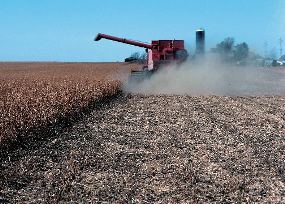
(Source: USDA - National Resources Conservation
Service) |
Harvesting crops involves getting the crop out
of the field and transported to market. Most crops are harvested
in the fall, except for hay which is cut several times over the
course of the summer.
Field crops are harvested by machine, while small fruits and other
food crops are typically harvested by hand, although in certain
cases, they may be harvested by machine. |
 Back
to Crop Production Menu Back
to Crop Production Menu
Operations and Timing:

(Source: USDA - National Resources Conservation
Service) |
| Crop |
Typical harvest period (in eastern
corn belt) |
| Corn - grain |
October 7 to November 3 |
| Corn - silage |
September 1 to October 15 |
| Soybeans |
October 1 to October 20 |
| Wheat (spring) |
August 14 to September 1 |
| Wheat (winter) |
June 15 to July 15 |
| Hay |
Usually 3 cuttings from May 15 to Sept. 30 |
Back to Top
Equipment Used:

|
| Farm tractor and tillage implement |
| (Source: Daniel R. Ess,
Purdue University) |
Tractors - are traction machines that provide mechanical,
hydraulic, and/or electrical power to implements to perform a wide range
of crop production and handling operations. Tractors are most often used
to perform drawbar work and PTO
(power take-off) work. Tractors can be equipped with rubber tires, rubber
belts, or steel tracks. A modern farm tractor is almost always equipped
with a diesel engine and tractor size is measured by the amount of power
that the tractor can produce at the PTO. Tractor sizes range for those with
less than 40 PTO horsepower to ones that produce more than 400 horsepower.
The cost of a large tractor can exceed $200,000.
| 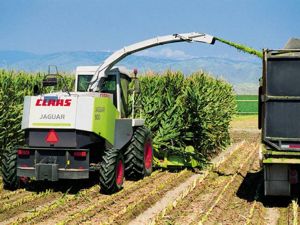
|
A self-propelled forage harvester
loading
chopped corn into a truck on-the-go. |
| (Source: Claas of America.)
|
Forage Harvesters - are tractor-drawn implements or self-propelled
machines that are used to gather, chop, and discharge forage crops as it
moves through the field. The crops are typically harvested at a very high
moisture content to permit ensiling
(preservation through anaerobic fermentation). Forage harvesters require
a great deal of power to perform the required functions. The largest self-propelled
forage harvesters currently available have diesel engines that produce in
excess of 600 horsepower.
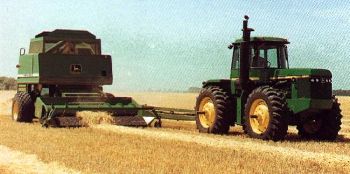
|
Tractor and pull-type combine operating
in a small grain crop. |
Combines - are farm machines used to harvest grain and
seed crops. The major functions performed by a combine include cutting
and/or gathering, feeding, threshing, separating, cleaning, and grain handling
operations on-the-go in the field. The vast majority are self-propelled,
receiving power to perform all of the previously listed operations and traction
from a diesel engine. The combine is often the most expensive farm machine
used in grain or row crop production with list prices for the largest models
exceeding $350,000. Some machines can harvest a thirty-foot swath of crop
in a single pass through the field.
| Self-propelled combine equipped
with a grain header. |

(Source: Daniel R. Ess, Purdue University)
|
| Self-propelled combine equipped
with a corn head preparing to harvest corn. |
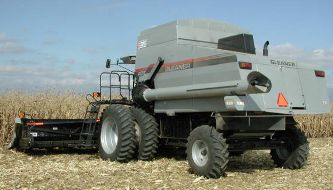
(Source: Daniel R. Ess, Purdue University)
|
| Cotton Harvesters
- are self-propelled machines specifically designed to pick (or strip),
accumulate, and off-load large quantities of cotton in the field. |
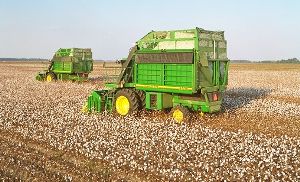
|
| Cotton harvesters at work in
the field. |
| (Source: Deere Photo
Library, Vol. 3.) |
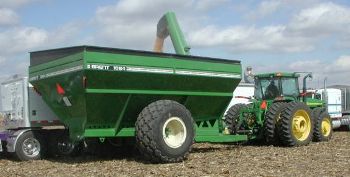
|
A large-capacity grain cart
unloading into a waiting
truck. |
| (Source: Daniel R. Ess,
Purdue University) |
Grain Carts - are tractor-drawn implements used to shuttle
grain from combines to hauling vehicles or to grain receiving facilities.
Grain carts are usually equipped with “high-flotation” tires or rubber tracks
to attempt to minimize soil compaction in the field. The capacity of such
carts can exceed 1,000 bushels (equivalent to 56,000 lb of shelled corn
or 60,000 lb of soybeans).
Balers - are implements used for packaging hay, or
straw to permit mechanized handling and transport. The two most common
bale formats are large round bales (> 4 feet in diameter) and large
rectangular bales (up to 8 feet in length). Large bales can weigh more
than 2,000 pounds.
| Large round baler discharging a newly-formed
bale of hay. |
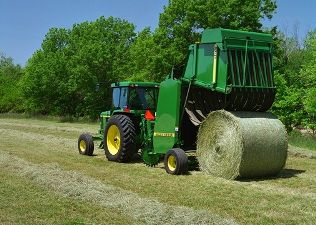
(Source: Deere Photo Library, Vol. 3.) |
| Large rectangular baler discharging
a newly-formed bale of straw. |
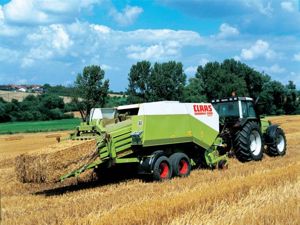
(Source: Class of America.) |
Back to Top
 Back
to Crop Production Menu Back
to Crop Production Menu
|

